Deciphering the Reactive Pathways of Competitive Reactions inside Carbon Nanotubes
Abstract
:1. Introduction
2. Materials and Methods
3. Results and Discussion
3.1. Potential Energy Surfaces for SN2, anti-E2, and syn-E2 Reactions in the Gas Phase
3.2. Potential Energy Surfaces for SN2, anti-E2, and syn-E2 Reactions Confined in CNTs
3.2.1. Substitution Mechanism (SN2)
3.2.2. Elimination Mechanism (E2)
4. Conclusions
Supplementary Materials
Author Contributions
Funding
Data Availability Statement
Acknowledgments
Conflicts of Interest
References
- Mouarrawis, V.; Plessius, R.; van der Vlugt, J.I.; Reek, J.N.H. Confinement Effects in Catalysis Using Well-Defined Materials and Cages. Front. Chem. 2018, 6, 623. [Google Scholar] [CrossRef] [PubMed] [Green Version]
- Chakraborty, D.; Chattararaj, P.K. Bonding, Reactivity, and Dynamics in Confined Systems. J. Phys. Chem. 2019, 123, 4513. [Google Scholar] [CrossRef] [PubMed] [Green Version]
- Santiso, E.E.; George, A.M.; Turner, C.H.; Kostov, M.K.; Gubbins, K.E.; Buongiorno-Nardelli, M.; Sliwinska-Bartkowiak, M. Adsorption and Catalysis: The Effect of Confinement on Chemical Reactions. Appl. Surf. Sci. 2005, 252, 766. [Google Scholar] [CrossRef]
- Dai, J.; Zhang, H.; Dai, J.J.; Zhang, H. Recent Advances in Catalytic Confinement Effect within Micro/Meso-Porous Crystalline Materials. Small 2021, 17, 2005334. [Google Scholar] [CrossRef]
- Yu, Z.; Ji, N.; Li, X.; Zhang, R.; Qiao, Y.; Xiong, J.; Liu, J.; Lu, X.; Yu, Z.; Ji, N.; et al. Kinetics Driven by Hollow Nanoreactors: An Opportunity for Controllable Catalysis. Angew. Chem. Int. Ed. 2022, in press. [Google Scholar]
- Khlobystov, A.N.; Britz, D.A.; Briggs, G.A.D. Molecules in Carbon Nanotubes. Acc. Chem. Res. 2005, 38, 901. [Google Scholar] [CrossRef]
- Britz, D.A.; Khlobystov, A.N. Noncovalent Interactions of Molecules with Single Walled Carbon Nanotubes. Chem. Soc. Rev. 2006, 35, 637. [Google Scholar] [CrossRef]
- Serp, P.; Castillejos, E. Catalysis in Carbon Nanotubes. ChemCatChem 2010, 2, 41. [Google Scholar] [CrossRef]
- Khlobystov, A.N. Carbon Nanotubes: From Nano Test Tube to Nano-Reactor. ACS Nano 2011, 5, 9306. [Google Scholar] [CrossRef]
- Miners, S.A.; Rance, G.A.; Khlobystov, A.N. Regioselective Control of Aromatic Halogenation Reactions in Carbon Nanotube Nanoreactors. Chem. Commun. 2013, 49, 5586. [Google Scholar] [CrossRef]
- Xiao, J.; Pan, X.; Guo, S.; Ren, P.; Bao, X. Toward Fundamentals of Confined Catalysis in Carbon Nanotubes. J. Am. Chem. Soc. 2015, 137, 477. [Google Scholar] [CrossRef] [PubMed]
- Miners, S.A.; Rance, G.A.; Khlobystov, A.N. Chemical Reactions Confined within Carbon Nanotubes. Chem. Soc. Rev. 2016, 45, 4727. [Google Scholar] [CrossRef] [PubMed]
- Miners, S.A.; Fay, M.W.; Baldoni, M.; Besley, E.; Khlobystov, A.N.; Rance, G.A. Steric and Electronic Control of 1,3-Dipolar Cycloaddition Reactions in Carbon Nanotube Nanoreactors. J. Phys. Chem. 2019, 123, 6294. [Google Scholar] [CrossRef]
- Iglesias, D.; Melchionna, M. Enter the Tubes: Carbon Nanotube Endohedral Catalysis. Catalysts 2019, 9, 128. [Google Scholar] [CrossRef] [Green Version]
- Solomonsz, W.A.; Rance, G.A.; Khlobystov, A.N. Evaluating the Effects of Carbon Nanoreactor Diameter and Internal Structure on the Pathways of the Catalytic Hydrosilylation Reaction. Small 2014, 10, 1866. [Google Scholar] [CrossRef]
- Solomonsz, W.A.; Rance, G.A.; Suyetin, M.; la Torre, A.; Bichoutskaia, E.; Khlobystov, A.N. Controlling the Regioselectivity of the Hydrosilylation Reaction in Carbon Nanoreactors. Chem. A Eur. J. 2012, 18, 13180. [Google Scholar] [CrossRef]
- Rance, G.A.; Solomonsz, W.A.; Khlobystov, A.N. Click Chemistry in Carbon Nanoreactors. Chem. Commun. 2013, 49, 1067. [Google Scholar] [CrossRef]
- Solomonsz, W.A.; Rance, G.A.; Harris, B.J.; Khlobystov, A.N. Competitive Hydrosilylation in Carbon Nanoreactors: Probing the Effect of Nanoscale Confinement on Selectivity. Nanoscale 2013, 5, 12200. [Google Scholar] [CrossRef]
- Rance, G.A.; Miners, S.A.; Chamberlain, T.W.; Khlobystov, A.N. The Effect of Carbon Nanotubes on Chiral Chemical Reactions. Chem. Phys. Lett. 2013, 557, 10. [Google Scholar] [CrossRef]
- Pan, X.; Bao, X. The Effects of Confinement inside Carbon Nanotubes on Catalysis. Acc. Chem. Res. 2011, 44, 553. [Google Scholar] [CrossRef]
- Kondratyuk, P.; Yates, J.T. Molecular Views of Physical Adsorption inside and Outside of Single-Wall Carbon Nanotubes. Acc. Chem. Res. 2007, 40, 995. [Google Scholar] [CrossRef] [PubMed]
- Alves, I.; Magalhães, A.L. BN-Doped Graphene and Single-Walled Carbon Nanotubes for the Catalysis of SN2 Reactions: Insights from Density Functional Theory Modeling. J. Phys. Chem. 2019, 123, 8188. [Google Scholar] [CrossRef] [PubMed]
- Tavares, I.S.; Figueiredo, C.F.B.R.; Magalhães, A.L. The Inner Cavity of a Carbon Nanotube as a Chemical Reactor: Effect of Geometry on the Catalysis of a Menshutkin SN2 Reaction. J. Phys. Chem. 2017, 121, 2165. [Google Scholar] [CrossRef]
- Kuznetsov, V. Stereochemistry of Simple Molecules inside Nanotubes and Fullerenes: Unusual Behavior of Usual Systems. Molecules 2020, 25, 2437. [Google Scholar] [CrossRef] [PubMed]
- Halls, M.D.; Schlegel, H.B. Chemistry Inside Carbon Nanotubes: The Menshutkin SN2 Reaction. J. Phys. Chem. 2002, 106, 1921. [Google Scholar] [CrossRef] [Green Version]
- Halls, M.D.; Raghavachari, K. Carbon Nanotube Inner Phase Chemistry: The Cl− Exchange SN2 Reaction. Nano. Lett. 2005, 5, 1861. [Google Scholar] [CrossRef]
- Santiso, E.E.; George, A.M.; Gubbins, K.E.; Buongiorno Nardelli, M. Effect of Confinement by Porous Carbons on the Unimolecular Decomposition of Formaldehyde. J. Chem. Phys. 2006, 125, 84711. [Google Scholar] [CrossRef]
- Lu, T.; Goldfield, E.M.; Gray, S.K. Classical Trajectory Studies of the D + H2 → HD + H Reaction Confined in Carbon Nanotubes: Parallel Trajectories. J. Phys. Chem. 2008, 112, 15260. [Google Scholar] [CrossRef]
- Lu, T.; Goldfield, E.M.; Gray, S.K. Chemical Reactivity within Carbon Nanotubes: A Quantum Mechanical Study of the D + H2 → HD + H Reaction. J. Phys. Chem. 2008, 112, 2654. [Google Scholar] [CrossRef]
- Trzaskowski, B.; Adamowicz, L. Chloromethane and Dichloromethane Decompositions Inside Nanotubes as Models of Reactions in Confined Space. Theor. Chem. Acc. 2009, 124, 95. [Google Scholar] [CrossRef]
- Wang, L.; Yi, C.; Zou, H.; Xu, J.; Xu, W. Rearrangement and Thermal Decomposition of Nitromethane Confined Inside an Armchair (5, 5) Single-Walled Carbon Nanotube. Chem. Phys. 2010, 367, 120. [Google Scholar] [CrossRef]
- Wang, L.; Xu, J.; Yi, C.; Zou, H.; Xu, W. Theoretical Study on the Thermal Decomposition of Nitromethane Encapsulated Inside Single-Walled Carbon Nanotubes. J. Mol. Struct. Theochem. 2010, 940, 76. [Google Scholar] [CrossRef]
- Lu, T.; Goldfield, E.M.; Gray, S.K. Classical Trajectory Studies of the D + H2 → HD + H Reaction Confined in Carbon Nanotubes: Effects of Collisions with the Nanotube Walls. J. Phys. Chem. 2010, 114, 9030. [Google Scholar] [CrossRef]
- Feng, H.; Qian, Z.; Wang, C.; Chen, C.; Chen, J. Tuning the Energy Barrier of Water Exchange Reactions on Al (III) by Interaction with the Single-Walled Carbon Nanotubes. Dalton Trans. 2011, 40, 4183. [Google Scholar] [CrossRef]
- Wang, L.; Yi, C.; Zou, H.; Gan, H.; Xu, J.; Xu, W. Initial Reactions of Methyl-Nitramine Confined Inside Armchair (5, 5) Single-Walled Carbon Nanotube. J. Mol. Model. 2011, 17, 2751. [Google Scholar] [CrossRef]
- Wang, L.; Yi, C.; Zou, H.; Xu, J.; Xu, W. On the Isomerization and Dissociation of Nitramide Encapsulated Inside an Armchair (5, 5) Single-Walled Carbon Nanotube. Mater. Chem. Phys. 2011, 127, 232. [Google Scholar] [CrossRef]
- Wang, W.; Wang, D.; Zhang, Y.; Ji, B.; Tian, A. Hydrogen Bond and Halogen Bond Inside the Carbon Nanotube. J. Chem. Phys. 2011, 134, 54317. [Google Scholar] [CrossRef]
- Ravinder, P.; Subramanian, V. Thermo Neutral SN2 Reaction within Pristine and Stone-Wales Defective BNNTs and CNTs. J. Phys. Chem. 2013, 117, 5095. [Google Scholar] [CrossRef]
- Giacinto, P.; Bottoni, A.; Calvaresi, M.; Zerbetto, F. Cl(−) Exchange SN2 Reaction inside Carbon Nanotubes: C-H···π and Cl···π Interactions Govern the Course of the Reaction. J. Phys. Chem. C 2014, 118, 5032. [Google Scholar] [CrossRef]
- Giacinto, P.; Zerbetto, F.; Bottoni, A.; Calvaresi, M. CNT-Confinement Effects on the Menshutkin SN2 Reaction: The Role of Nonbonded Interactions. J. Chem. Theory Comput. 2016, 12, 4082. [Google Scholar] [CrossRef]
- Marforio, T.D.; Bottoni, A.; Giacinto, P.; Zerbetto, F.; Calvaresi, M. Aromatic Bromination of N-Phenylacetamide Inside CNTs. Are CNTs Real Nanoreactors Controlling Regioselectivity and Kinetics? A QM/MM Investigation. J. Phys. Chem. 2017, 121, 27674. [Google Scholar] [CrossRef]
- Mejri, A.; Picaud, F.; el Khalifi, M.; Gharbi, T.; Tangour, B. Controlling Activation Barrier by Carbon Nanotubes as Nano-Chemical. J. Mol. Model. 2017, 23, 229. [Google Scholar] [CrossRef] [PubMed]
- Fedoseeva, Y.V.; Orekhov, A.S.; Chekhova, G.N.; Koroteev, V.O.; Kanygin, M.A.; Seovskiy, B.V.; Chuvilin, A.; Pontiroli, D.; Ricco, M.; Bulusheva, L.G.; et al. Single-Walled Carbon Nanotube Reactor for Redox Transformation of Mercury Dichloride. ACS Nano 2017, 11, 8643. [Google Scholar] [CrossRef] [PubMed]
- Zhao, Y.; Truhlar, D.G. The M06 Suite of Density Functionals for Main Group Thermochemistry, Thermochemical Kinetics, Noncovalent Interactions, Excited States, and Transition Elements: Two New Functionals and Systematic Testing of Four M06-Class Functionals and 12 Other Functionals. Theor. Chem. Acc. 2008, 120, 215. [Google Scholar]
- Bento, A.P.; Sola, M.; Bickelhaupt, F.M. E2 and S(N)2 Reactions of X− + CH3CH2X (X = F, Cl); an Ab Initio and DFT Benchmark Study. J. Chem. Theory Comput. 2008, 4, 929. [Google Scholar] [CrossRef]
- Zhao, Y.; Truhlar, D.G. Density Functional Calculations of E2 and SN2 Reactions: Effects of the Choice of Density Functional, Basis Set, and Self-Consistent Iterations. J. Chem. Theory Comput. 2010, 6, 1104. [Google Scholar] [CrossRef]
- Frisch, M.J.; Pople, J.A.; Binkley, J.S. Self-Consistent Molecular Orbital Methods Supplementary Functions for Gaussian Basis Sets. J. Chem. Phys. 1984, 80, 3265. [Google Scholar] [CrossRef]
- Humphrey, W.; Dalke, A.; Schulten, K. VMD—Visual Molecular Dynamics. J. Mol. Graph. 1996, 14, 33. [Google Scholar] [CrossRef]
- Dapprich, S.; Komáromi, I.; Byun, K.S.; Morokuma, K.; Frisch, M.J. A New ONIOM Implementation in Gaussian Part I. The Calculation of Energies, Gradients, Vibrational Frequencies and Electric Field Derivatives. Comput. Theor. Chem. 1999, 461, 1–21. [Google Scholar]
- Frisch, M.J.; Trucks, G.W.; Schlegel, H.B.; Scuseria, G.E.; Robb, M.A.; Cheeseman, J.R.; Scalmani, G.; Barone, V.; Petersson, G.A.; Nakatsuji, H.; et al. Gaussian16 Revision C.01; Gaussian Inc.: Wallingford, CT, USA, 2016. [Google Scholar]
- Vreven, T.; Byun, K.S.; Komáromi, I.; Dapprich, S.; Montgomery, J.A.; Morokuma, K.; Frisch, M.J. Combining Quantum Mechanics Methods with Molecular Mechanics Methods in ONIOM. J. Chem. Theory Comput. 2006, 2, 815. [Google Scholar] [CrossRef]
- Chung, L.W.; Sameera, W.M.C.; Ramozzi, R.; Page, A.J.; Hatanaka, M.; Petrova, G.P.; Harris, T.V.; Li, X.; Ke, Z.; Liu, F.; et al. The ONIOM Method and Its Applications. Chem. Rev. 2015, 115, 5678. [Google Scholar] [PubMed] [Green Version]
- Vreven, T.; Morokuma, K.; Farkas, Ö.; Schlegel, H.B.; Frisch, M.J. Geometry Optimization with QM/MM, ONIOM and Other Combined Methods. I. Micro-Iterations and Constraints. J. Comput. Chem. 2003, 24, 760. [Google Scholar] [CrossRef] [PubMed]
- Rappé, A.K.; Casewit, C.J.; Colwell, K.S.; Goddard, W.A.; Skiff, W.M. UFF, a Full Periodic-Table Force-Field for Molecular Mechanics and Molecular-Dynamics Simulations. J. Am. Chem. Soc. 1992, 114, 10024. [Google Scholar] [CrossRef]
- Rappé, A.K.; Goddard, W.A. Charge Equilibration for Molecular-Dynamics Simulations. J. Phys. Chem. 1991, 95, 3358. [Google Scholar] [CrossRef]
- Van Zeist, W.J.; Bickelhaupt, F.M. The Activation Strain Model of Chemical Reactivity. Org. Biomol. Chem. 2010, 8, 3118. [Google Scholar] [CrossRef] [PubMed]
- Khaliha, S.; Marforio, T.D.; Kovtun, A.; Mantovani, S.; Bianchi, A.; Luisa Navacchia, M.; Zambianchi, M.; Bocchi, L.; Boulanger, N.; Iakunkov, A.; et al. Defective Graphene Nanosheets for Drinking Water Purification: Adsorption Mechanism, Performance, and Recovery. FlatChem 2021, 29, 100283. [Google Scholar] [CrossRef]
- Di Giosia, M.; Zerbetto, F.; Calvaresi, M. Incorporation of Molecular Nanoparticles Inside Proteins: The Trojan Horse Approach in Theranostics. Acc. Mater. Res. 2021, 2, 59. [Google Scholar] [CrossRef]
- Berto, M.; di Giosia, M.; Giordani, M.; Sensi, M.; Valle, F.; Alessandrini, A.; Menozzi, C.; Cantelli, A.; Gazzadi, G.C.; Zerbetto, F.; et al. Green Fabrication of (6, 5) Carbon Nanotube/Protein Transistor Endowed with Specific Recognition. Adv. Electron. Mater. 2021, 7, 2001114. [Google Scholar] [CrossRef]
- Di Giosia, M.; Marforio, T.D.; Cantelli, A.; Valle, F.; Zerbetto, F.; Su, Q.; Wang, H.; Calvaresi, M. Inhibition of α-Chymotrypsin by Pristine Single-Wall Carbon Nanotubes: Clogging up the Active Site. J. Colloid Interface Sci. 2020, 571, 174. [Google Scholar] [CrossRef]
- Di Giosia, M.; Valle, F.; Cantelli, A.; Bottoni, A.; Zerbetto, F.; Fasoli, E.; Calvaresi, M. Identification and Preparation of Stable Water Dispersions of Protein—Carbon Nanotube Hybrids and Efficient Design of New Functional Materials. Carbon N. Y. 2019, 147, 70. [Google Scholar] [CrossRef]
- Calvaresi, M.; Bottoni, A.; Zerbetto, F. Thermodynamics of Binding between Proteins and Carbon Nanoparticles: The Case of C60@Lysozyme. J. Phys. Chem. 2015, 119, 28077. [Google Scholar] [CrossRef] [Green Version]
- Shi, L.; Rohringer, P.; Suenaga, K.; Niimi, Y.; Kotakoski, J.; Meyer, J.C.; Peterlik, H.; Wanko, M.; Cahangirov, S.; Rubio, A.; et al. Confined Linear Carbon Chains as a Route to Bulk Carbyne. Nat. Mater. 2016, 15, 634. [Google Scholar] [CrossRef] [PubMed]
- Miyaura, K.; Miyata, Y.; Thendie, B.; Yanagi, K.; Kitaura, R.; Yamamoto, Y.; Arai, S.; Kataura, H.; Shinohara, H. Extended-Conjugation π-Electron Systems in Carbon Nanotubes. Sci. Rep. 2018, 8, 8098. [Google Scholar] [CrossRef]
- Nishide, D.; Dohi, H.; Wakabayashi, T.; Nishibori, E.; Aoyagi, S.; Ishida, M.; Kikuchi, S.; Kitaura, R.; Sugai, T.; Sakata, M.; et al. Single-Wall Carbon Nanotubes Encaging Linear Chain C10H2 Polyyne Molecules Inside. Chem. Phys. Lett. 2006, 428, 356. [Google Scholar] [CrossRef]
- Nishide, D.; Wakabayashi, T.; Sugai, T.; Kitaura, R.; Kataura, H.; Achiba, Y.; Shinohara, H. Raman Spectroscopy of Size-Selected Linear Polyyne Molecules C 2nH2 (n = 4–6) Encapsulated in Single-Wall Carbon Nanotubes. J. Phys. Chem. 2007, 111, 5178. [Google Scholar]
- Chang, W.; Liu, F.; Liu, Y.; Zhu, T.; Fang, L.; Li, Q.; Liu, Y.; Zhao, X. Smallest Carbon Nanowires Made Easy: Long Linear Carbon Chains Confined inside Single-Walled Carbon Nanotubes. Carbon 2021, 183, 571. [Google Scholar] [CrossRef]
- Gao, E.; Li, R.; Baughman, R.H. Predicted Confinement-Enhanced Stability and Extraordinary Mechanical Properties for Carbon Nanotube Wrapped Chains of Linear Carbon. ACS Nano 2020, 14, 17071. [Google Scholar] [CrossRef]
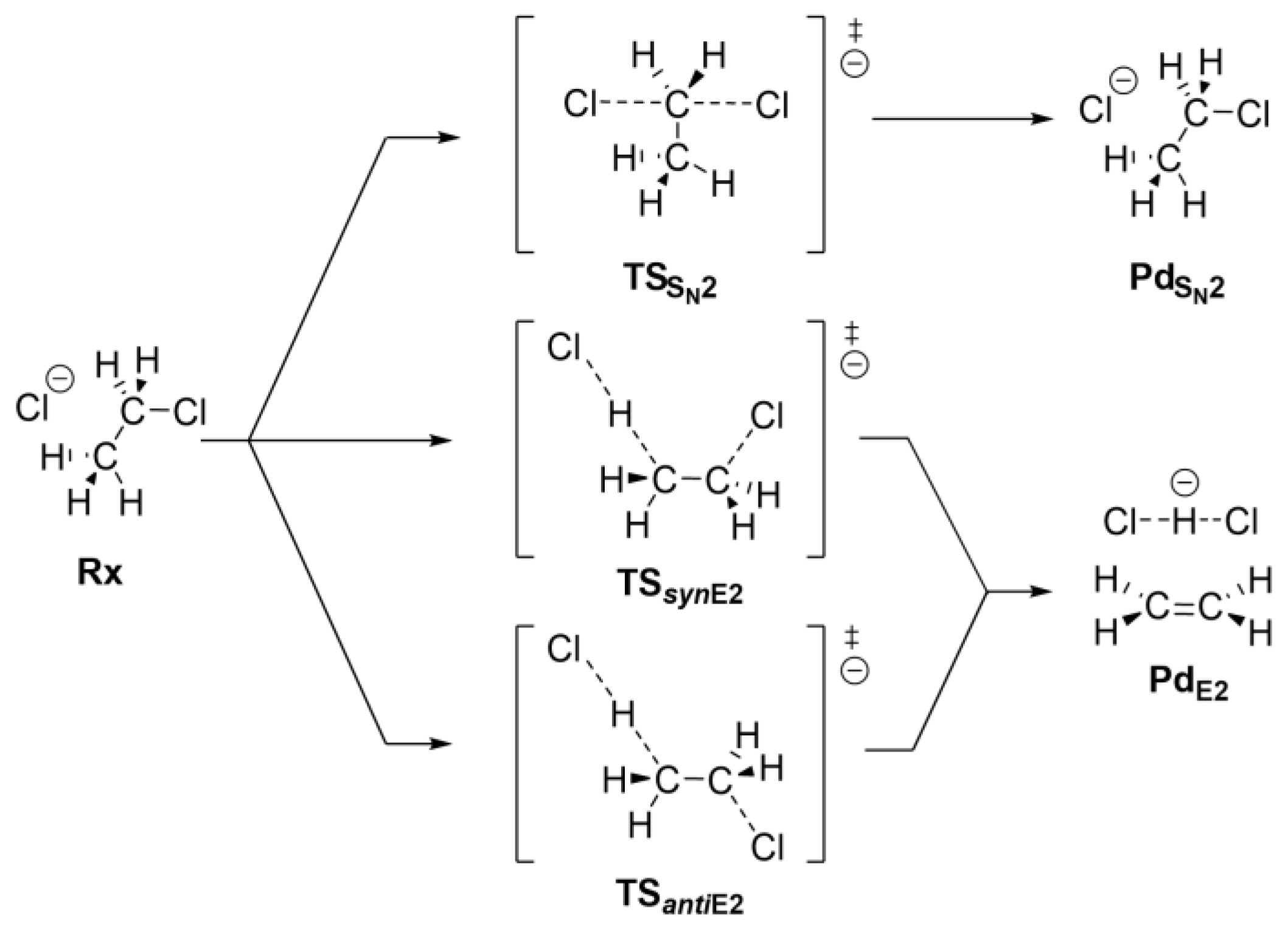
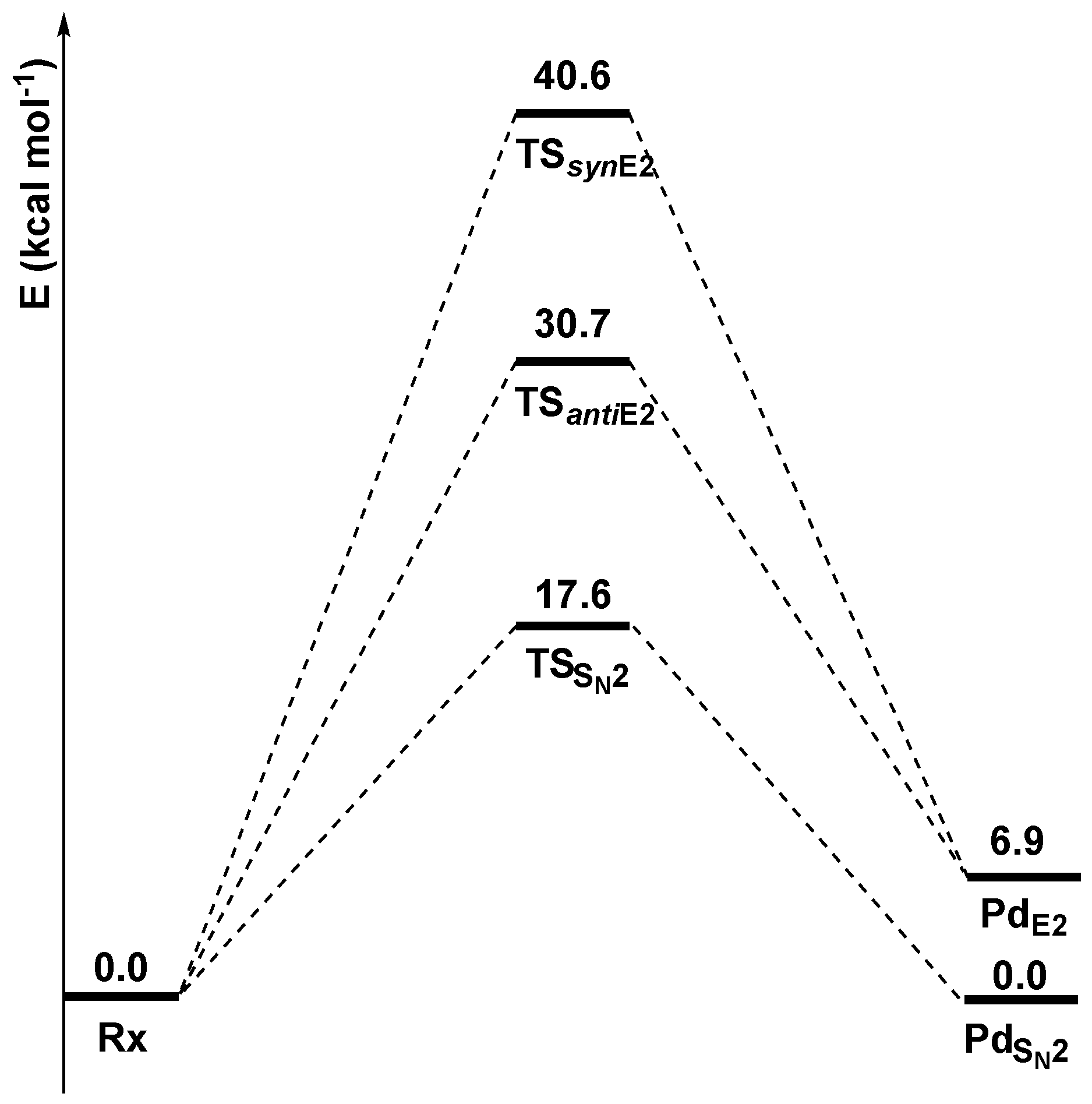
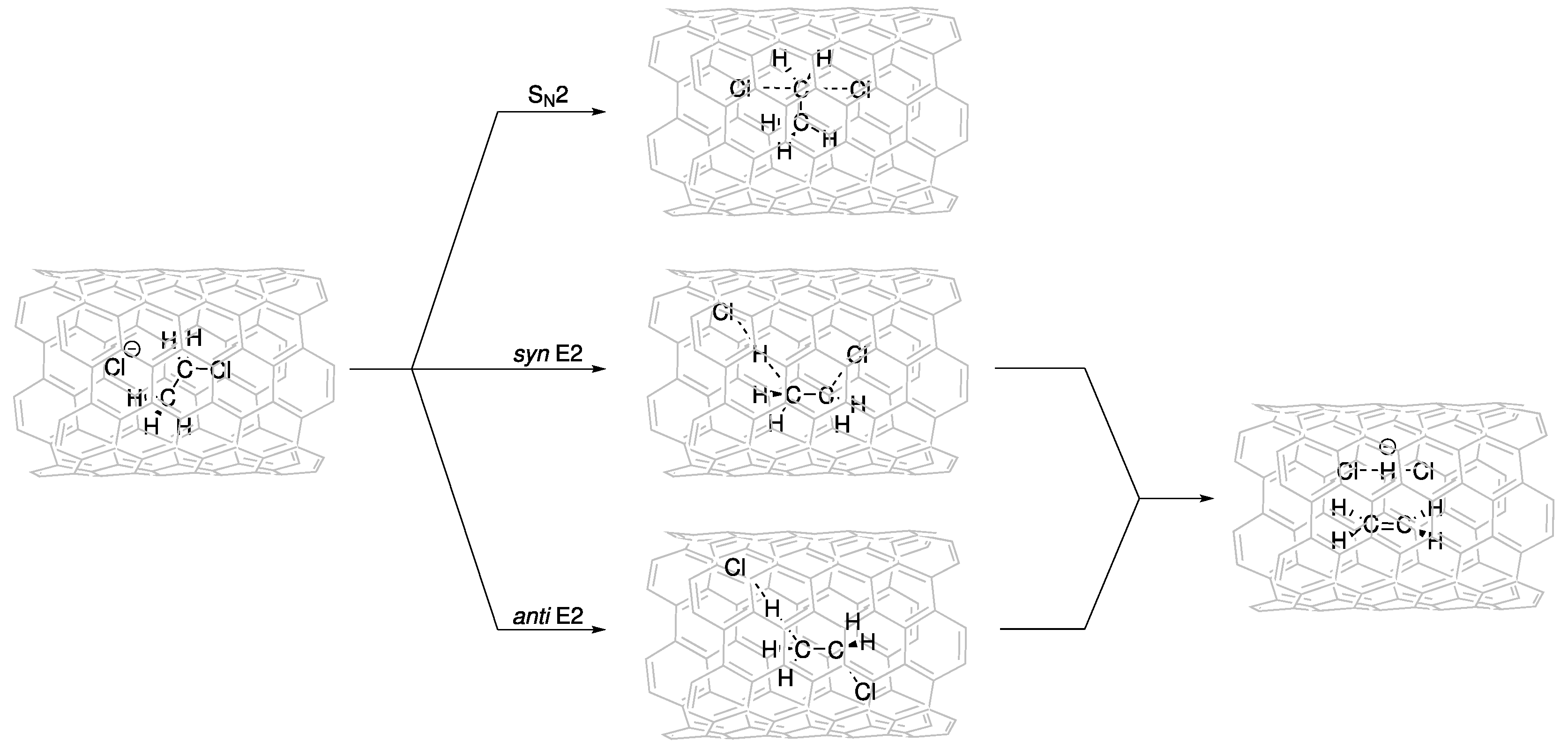
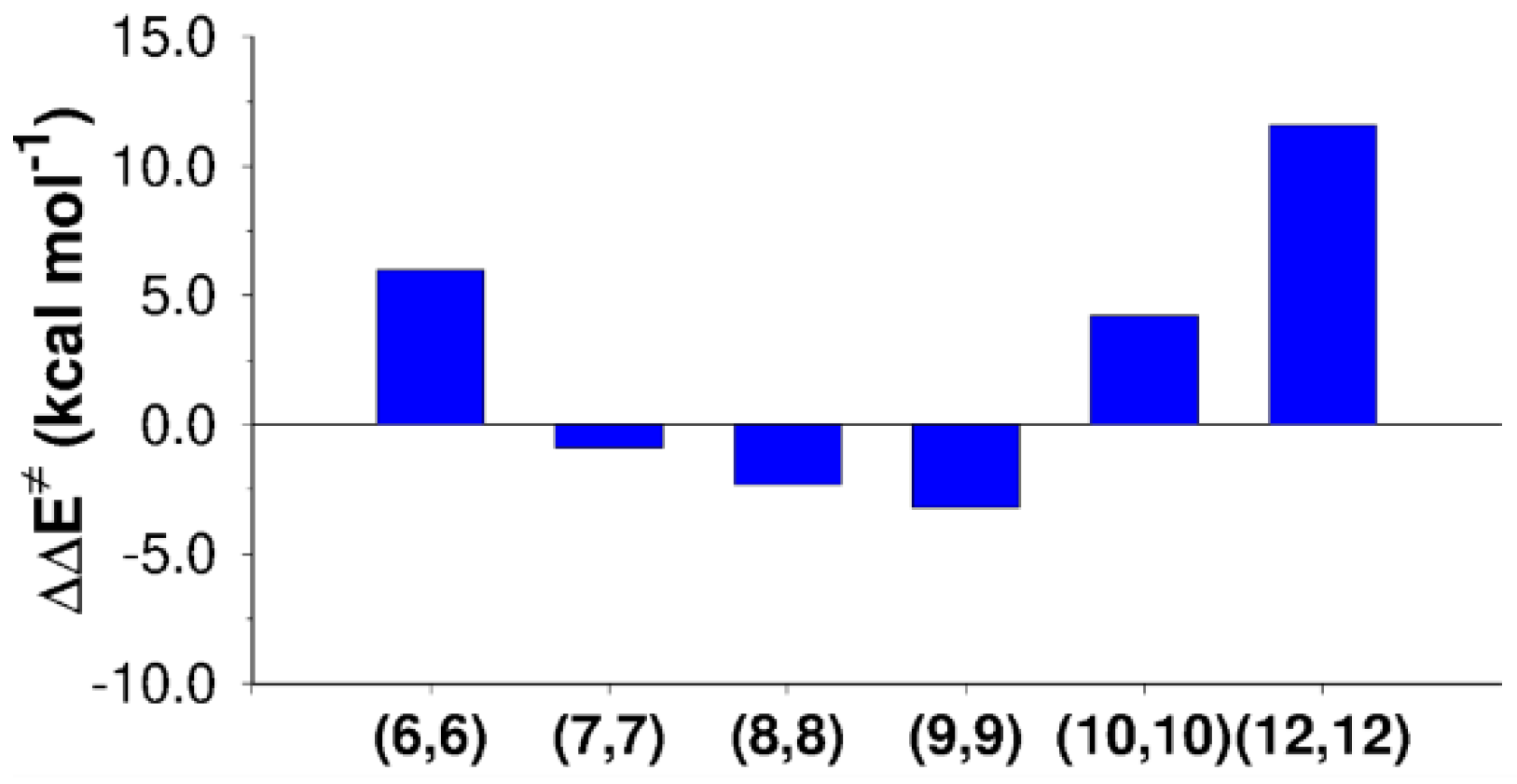


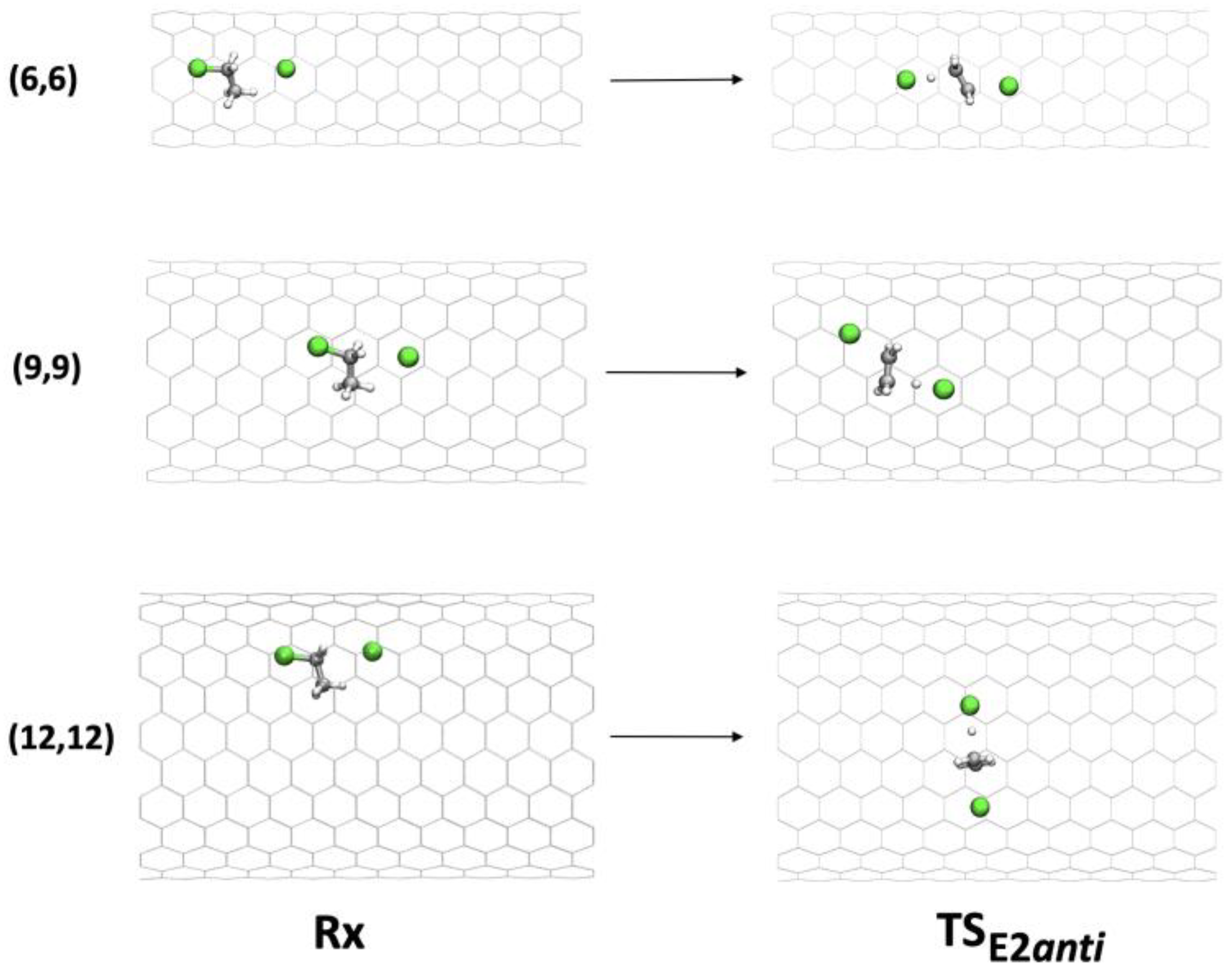
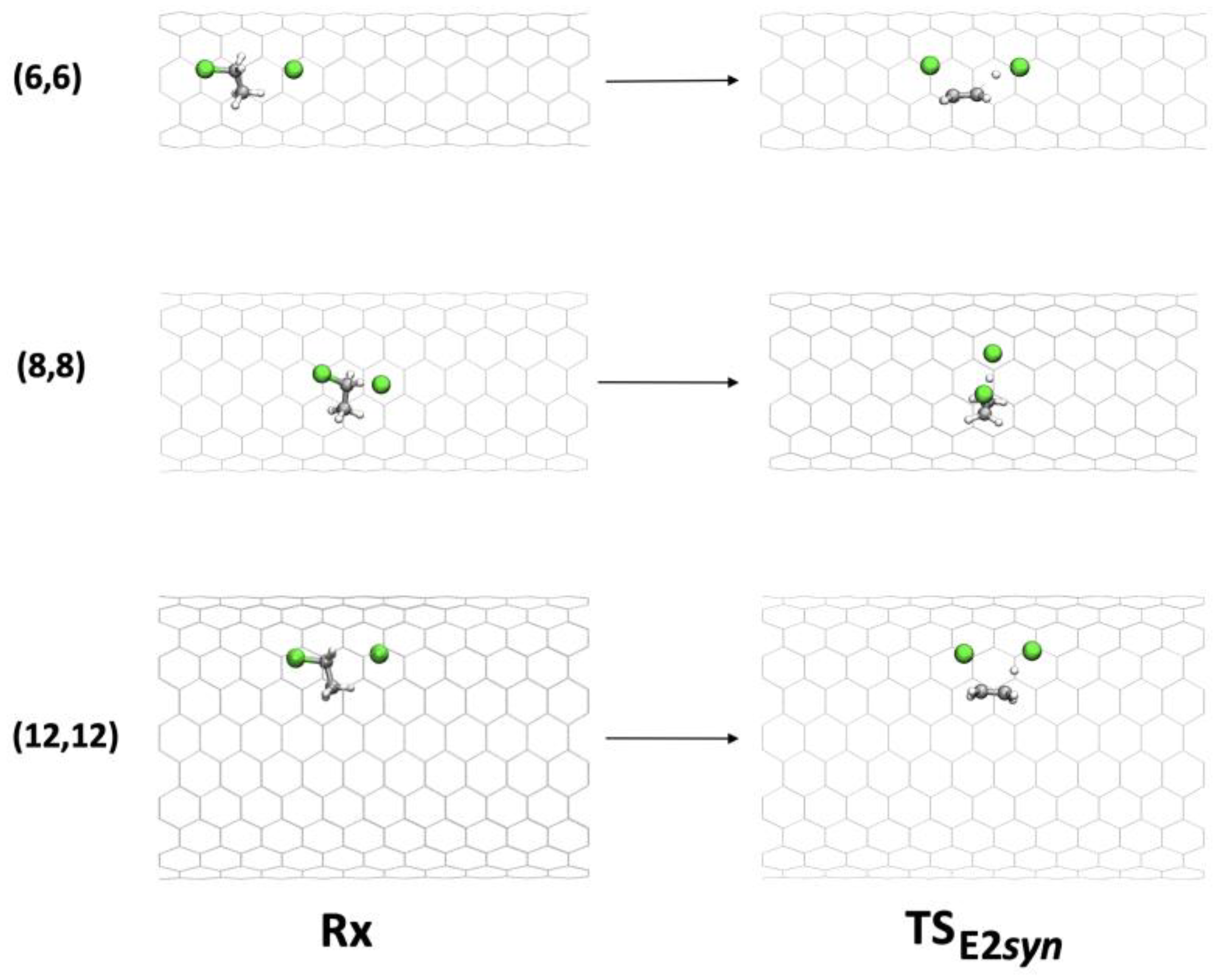
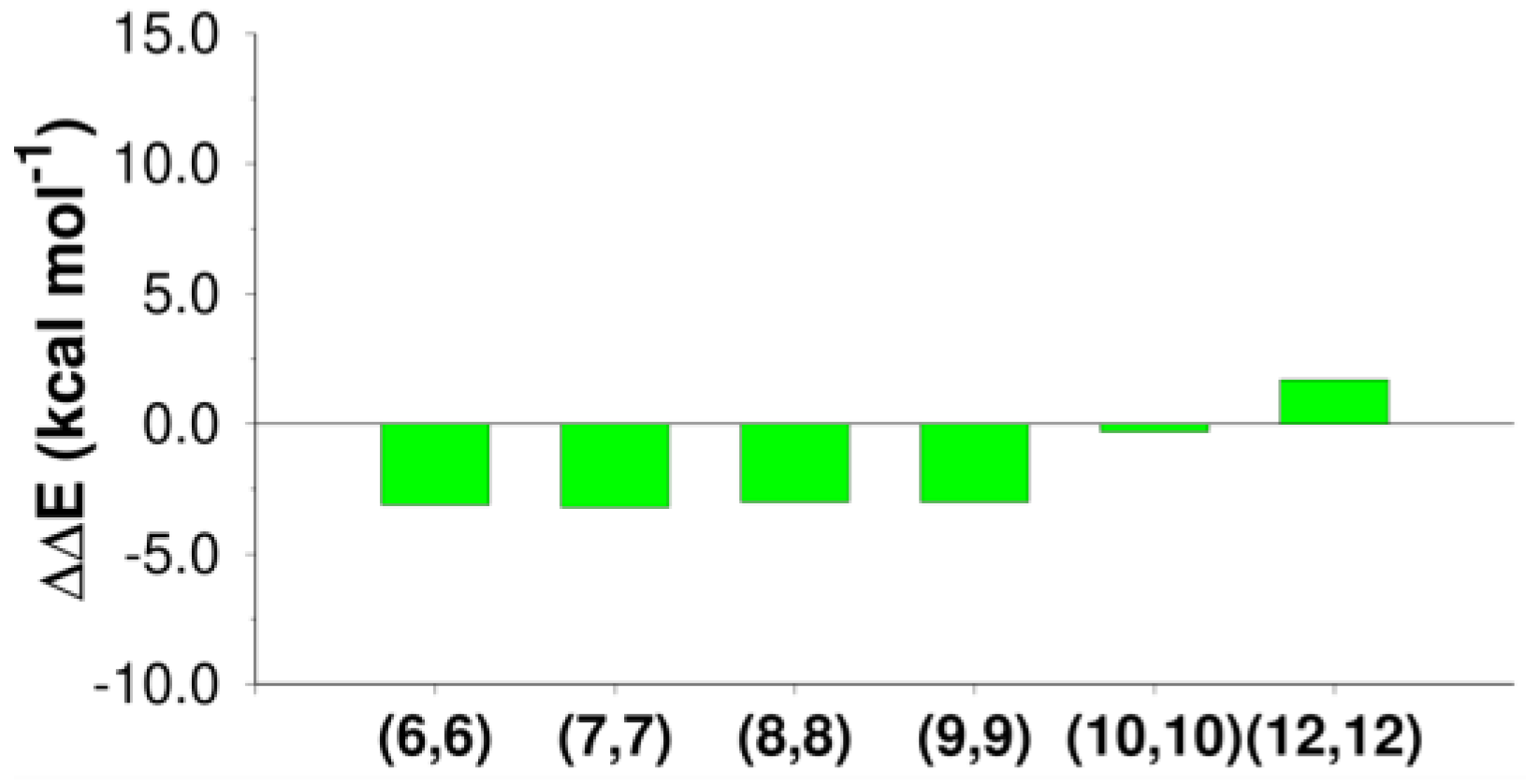
| SN2 | syn-E2 | anti-E2 | E2 | ||
|---|---|---|---|---|---|
| Basis Set | |||||
| CCSD(T) | CBS [45] | 17.5 | 42.6 | 29.9 | 6.9 |
| M06-2X | 6-311++G(2df,2p) | 17.6 | 40.6 | 30.7 | 6.9 |
| Gas Phase | (6,6) | (7,7) | (8,8) | (9,9) | (10,10) | (12,12) | ||
|---|---|---|---|---|---|---|---|---|
| SN2 | 17.6 | 23.6 | 16.7 | 15.4 | 14.1 | 21.8 | 29.2 | |
| syn-E2 | 40.6 | 51.4 | 37.8 | 32.3 | 38.0 | 44.3 | 50.3 | |
| anti-E2 | 30.7 | 34.1 | 31.8 | 32.6 | 29.1 | 36.2 | 44.9 |
| Gas Phase | (6,6) | (7,7) | (8,8) | (9,9) | (10,10) | (12,12) | ||
|---|---|---|---|---|---|---|---|---|
| SN2 | 0.0 | 0.0 | 0.0 | 0.0 | 0.0 | 0.0 | 0.0 | |
| E2 | 6.9 | 3.8 | 3.3 | 3.9 | 3.8 | 6.6 | 8.6 |
| SN2 | ||||||
|---|---|---|---|---|---|---|
| (6,6) | (7,7) | (8,8) | (9,9) | (10,10) | (12,12) | |
| 0.0 | 0.0 | 0.0 | 0.1 | 0.0 | −0.1 | |
| −0.2 | −0.2 | −0.7 | −0.4 | 0.4 | 0.0 | |
| 0.7 | 0.0 | 0.2 | 1.0 | −1.3 | −1.3 | |
| 5.5 | −0.7 | −1.9 | −4.0 | 5.1 | 12.9 | |
| 6.0 | −0.9 | −2.4 | −3.3 | 4.2 | 11.5 | |
| anti-E2 | ||||||
|---|---|---|---|---|---|---|
| (6,6) | (7,7) | (8,8) | (9,9) | (10,10) | (12,12) | |
| −0.6 | 0.0 | 0.0 | −0.1 | −0.1 | −0.3 | |
| −0.7 | 0.2 | −1.0 | −0.2 | 0.1 | 0.0 | |
| −3.6 | 1.3 | −1.7 | 0.8 | −0.5 | −2.4 | |
| 8.2 | −0.5 | 4.5 | −2.1 | 5.9 | 16.8 | |
| 3.3 | 1.0 | 1.8 | −1.6 | 5.4 | 14.1 | |
| syn-E2 | ||||||
|---|---|---|---|---|---|---|
| (6,6) | (7,7) | (8,8) | (9,9) | (10,10) | (12,12) | |
| 0.1 | 0.0 | 0.0 | 0.2 | −0.1 | 0.0 | |
| 4.7 | −0.1 | −1.0 | 0.2 | 0.2 | 0.2 | |
| 0.5 | −0.4 | −1.9 | −1.0 | 1.6 | 2.7 | |
| 5.5 | −2.2 | −5.4 | −1.9 | 2.0 | 6.8 | |
| 10.8 | −2.7 | −8.3 | −2.5 | 3.7 | 9.7 | |
| E2 | ||||||
|---|---|---|---|---|---|---|
| (6,6) | (7,7) | (8,8) | (9,9) | (10,10) | (12,12) | |
| −0.6 | 0.0 | 0.0 | 0.1 | 0.1 | −0.3 | |
| −0.4 | 1.2 | 2.2 | 0.5 | 0.8 | 0.7 | |
| −6.6 | 1.6 | −1.7 | −1.2 | −1.9 | −3.7 | |
| 4.5 | −6.0 | −3.5 | −2.4 | 0.7 | 5.0 | |
| −3.1 | −3.2 | −3.0 | −3.0 | −0.3 | 1.7 | |
Disclaimer/Publisher’s Note: The statements, opinions and data contained in all publications are solely those of the individual author(s) and contributor(s) and not of MDPI and/or the editor(s). MDPI and/or the editor(s) disclaim responsibility for any injury to people or property resulting from any ideas, methods, instructions or products referred to in the content. |
© 2022 by the authors. Licensee MDPI, Basel, Switzerland. This article is an open access article distributed under the terms and conditions of the Creative Commons Attribution (CC BY) license (https://creativecommons.org/licenses/by/4.0/).
Share and Cite
Marforio, T.D.; Tomasini, M.; Bottoni, A.; Zerbetto, F.; Mattioli, E.J.; Calvaresi, M. Deciphering the Reactive Pathways of Competitive Reactions inside Carbon Nanotubes. Nanomaterials 2023, 13, 8. https://doi.org/10.3390/nano13010008
Marforio TD, Tomasini M, Bottoni A, Zerbetto F, Mattioli EJ, Calvaresi M. Deciphering the Reactive Pathways of Competitive Reactions inside Carbon Nanotubes. Nanomaterials. 2023; 13(1):8. https://doi.org/10.3390/nano13010008
Chicago/Turabian StyleMarforio, Tainah Dorina, Michele Tomasini, Andrea Bottoni, Francesco Zerbetto, Edoardo Jun Mattioli, and Matteo Calvaresi. 2023. "Deciphering the Reactive Pathways of Competitive Reactions inside Carbon Nanotubes" Nanomaterials 13, no. 1: 8. https://doi.org/10.3390/nano13010008
APA StyleMarforio, T. D., Tomasini, M., Bottoni, A., Zerbetto, F., Mattioli, E. J., & Calvaresi, M. (2023). Deciphering the Reactive Pathways of Competitive Reactions inside Carbon Nanotubes. Nanomaterials, 13(1), 8. https://doi.org/10.3390/nano13010008








